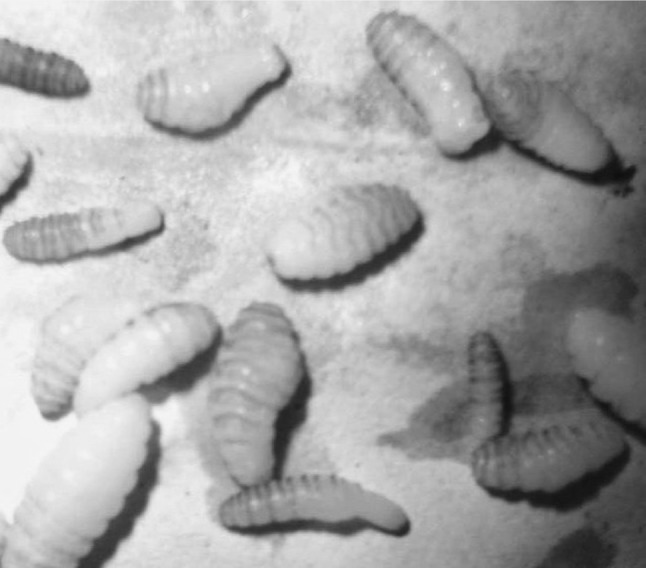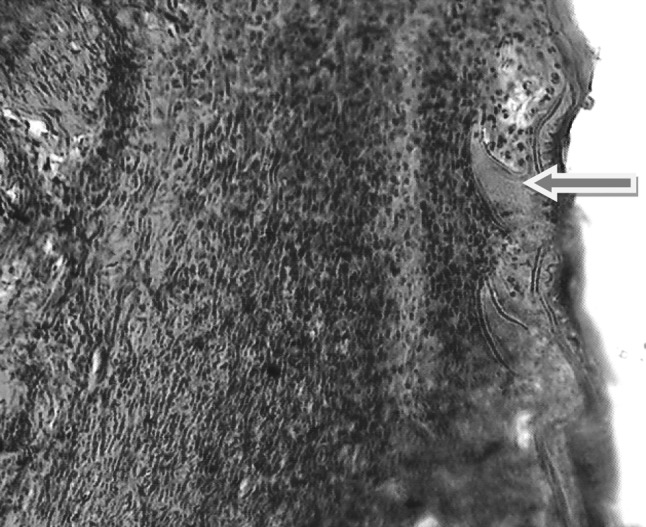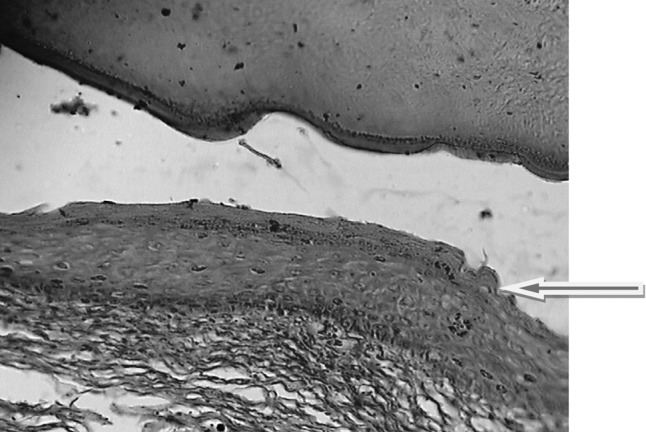Abstract
Warble fly infestation is primarily a myiasis of cattle and goat. However, a nondescript sheep from an endemic region was observed with nodules under subcutaneous tissue. So, this paper reports infestation of a sheep with Przhevalskiana silenus larvae in Jammu region of North India. The myiasis was confirmed with parasite morphology and specific histopathological changes observed in cutaneous myiasis.
Keywords: Myiasis, Przhevalskiana silenus, Sheep, India
Introduction
The infestation of goats with Przhevalskiana silenus larvae (order Diptera, family Oesttridae, subfamily Hypoderminae) is a commonly occurring myiasis in semi-hilly and mountainous areas of central Asian and Mediterranean countries (Zumpt 1965; Khan et al. 1991; Papadopoulos et al. 1997; Abo-Shehada et al. 2006; Yadav et al. 2011). It rarely occurs in sheep and Argali (Ovis ammon) (Zumpt 1965). It causes heavy economic losses by reduced weight gain, decreased meat and milk production and inflammatory reactions (Rahbari and Ghasemi 1997; Yadav et al. 2012). The disease is caused by the developing larval instars of P. silenus. First instar larvae emerge from the eggs laid directly on the back of the animal and finally cause formation of warbles in the loin, flank and the sacrum region (Soni 1942; Sen and Fletcher 1962). The paper presents the occurrence and histopathological findings of P. silenus infestation in a nondescript sheep from Jammu region of North India.
Materials and methods
The observations on warble fly infestation in sheep were made at Municipal Committee abattoir at Jammu, where sheep and goats are brought for slaughtering from ten districts of Jammu province of Jammu and Kashmir state of North India. During 7 years study from June 2004 to May 2011, a total of 10,320 sheep were examined for warble fly infestation by regular once or twice weekly visits. The observations made in last 7 years revealed that the prevalence of P. silenus infestation is very high in goats of Jammu province (Yadav et al. 2011). However, the examination of slaughtered sheep since commencement of study did not reveal any infestation by P. silenus larvae. Interestingly, on November 17, 2010, the examination of subcutaneous tissues of a nondescript adult sheep revealed the presence of nodular growths at the lumbar and sacrum regions. The history from the merchant revealed that the animal belongs to Rajouri district of Jammu province, which is an endemic area for P. silenus infestation in goats (Yadav et al. 2011).
The affected subcutaneous tissues were trimmed off and brought to the laboratory for examination. Subcutaneous tissues were carefully examined and dissected using ordinary stereomicroscope. The larvae were extracted and taxonomic identification was made as per the keys given by Sen and Fletcher (1962) and Zumpt (1965). In addition, small tissue pieces were taken from affected parts and fixed in 10 % neutral buffered formalin. These were processed for histopathological investigation following standard techniques (Luna 1968).
Results and discussion
During necropsy examination of a sheep, the nodules of 2–3 cm in diameter were observed in the subcutaneous tissues of lumbar and sacrum regions (Fig. 1). Careful examination revealed that some nodules were depressed; bluish-black in colour containing pyogenic material had dead and degraded larvae in it (Fig. 1). The larvae extracted from the subcutaneous tissues were barrel shaped, creamy-whitish in colour, measured 5–10 mm in length and had 11 segments bearing transverse rows of spines from 2nd to 8th segments (Fig. 2). Microscopic examination of creamy-whitish posterior spiracular plates with radiating furrows and excavated towards the spiracular orifice (Fig. 3) confirmed the identification of P. silenus larvae. The larvae extracted from pyogenic material were dead and degraded, measured 3–6 mm in length having 11 segments and were identified as the first instar larvae of P. silenus. 16 live second instar and 9 first instar larvae (3 live, 6 dead) were recovered from the subcutaneous tissues of sheep.
Fig. 1.

Subcutaneous tissue of sheep showing presence of live (blue arrow) and dead (red arrow) larvae of P. silenus. (Color figure online)
Fig. 2.

P. silenus larvae collected from sheep
Fig. 3.

Stigmal plates of P. silenus
Since early 20th century, the goat warble fly infestation has remained a major constraint on goat production in the Indian subcontinent (Cross 1926; Sen and Fletcher 1962). Recently, 47.22 % prevalence of P. silenus infestation in goats of Jammu province has been reported (Yadav et al. 2011), which result in an economic loss of US $1.62 million annually in terms of decreased meat and milk production (Yadav et al. 2012). Contrary to this, no report on the occurrence of P. silenus infestation in sheep is on record from the Indian subcontinent till date. Therefore, it seems first report on the occurrence of P. silenus larvae in subcutaneous tissues of a sheep and causing formation of warbles. However, a low prevalence (0.2 %) of P. silenus infestation in sheep had been reported from south-western Iran (Azizi et al. 2007). The probable reasons of the prevalence difference in sheep can be the kind of these animals. The goat body is covered with smooth hairs which is appropriate for laying eggs, hatching of larvae and their sloping towards the skin whereas the wool coat of sheep consists of thin, curly and luxuriant wool fibers and not a suitable place for oviposition of adult fly, hatching of larvae and their sloping down towards the skin (Jafari Shourigeh and Rezazadeh 1996).
In the region, the adult flies are active during summer from April to June, have short life span of about 5–7 days and possess affinity for goats to deposit eggs on hairs around the lumbar and sacrum. After emerging from the egg, the larvae grow and moult twice in the subcutaneous tissues of the back without going through further internal migration and finally, reach under the skin causing the characteristic warble swelling (Soni 1942; Otranto and Puccini 2000). Probably, under compulsion of not finding a goat and to ensure the survival of its progeny, the warble fly implicated and deposited its eggs on the wool of sheep.
The first stage larvae deeply penetrate into the subcutaneous tissues and/or hypodermal fascia, cause damage to the subcutaneous tissues with the help of oral hooks and cuticular spines resulting in cellular infiltration consisting of neutrophils, mononuclear cells and predominantly of eosinophils (Fig. 4). The death of the larvae in subcutaneous tissues may cause massive necrosis, severe infiltration of neutrophils and secondary bacterial infection resulting in pus formation. Consequently, the lesion is surrounded by lymphocytes, giant cells, eosinophils and fibroblast forming granuloma or pyogranuloma. After moulting, the cuticular spines of second stage larvae produce more severe inflammatory reactions and cellular infiltration consisting of mononuclear cells and eosinophils which lead to squamous metaplasia and keratinisation of subcutaneous tissues (Fig. 5).
Fig. 4.

Cross section of subcutaneous tissue showing severe cellular infiltration and cuticular spines of larva (arrow) (H & E, ×10)
Fig. 5.

Cross section showing squamous metaplasia having keratinized layer (arrow) (H & E, ×40)
The characteristic histopathological findings associated with P. silenus larvae and inflammatory cellular response in sheep is in confirmation with earlier descriptions on P. silenus larval infestation in goats (Oryan et al. 2009). There seems no authentic documentation on the histopathological findings of P. silenus larvae in sheep for the purpose of criticism/discussion.
In conclusion, warble fly infestation in small ruminant flocks largely account for extensive seasonal morbidity and consequential heavy economic losses to the farmers. The occurrence of P. silenus infestation in a sheep of high endemic region warrants an immediate need for launching a systematic planned warble fly control strategy in the endemic areas. Besides, the application of appropriate control measures against the adult fly during April to June or the mass treatment of flocks during late August to mid-September when the first instar larvae are present in the host would help in reducing the number of fly and sustain the optimal growth and productivity of sheep and goats and minimise the perpetuating financial losses to animal owners in the region.
Acknowledgments
The authors are grateful to the Sher-e-Kashmir University of Agricultural Sciences and Technology, Jammu, India for the encouragement and facilities provided. Thanks are also extended to the Commissioner Municipal Committee, Jammu, Dr. Y. Sharma and other staff members of Jammu slaughter house for their cooperation.
References
- Abo-Shehada MN, Batainah T, Abuharfeil NM, Torgerson PR. Przhevalskiana silenus myiasis among slaughter goats in northern Jordan. Vet Parasitol. 2006;137:345–350. doi: 10.1016/j.vetpar.2006.01.014. [DOI] [PubMed] [Google Scholar]
- Azizi H, Pourjafar M, Assadian F, Kahkesh F. A survey of seasonal infestation with Przhevalskiana larvae in slaughtered goats and sheep in south-western Iran. Pak J Biol Sci. 2007;21:3940–3943. doi: 10.3923/pjbs.2007.3940.3943. [DOI] [PubMed] [Google Scholar]
- Cross HE. Flies of the Punjab. Pusa: Bulletin Agriculture Research Institute; 1926. p. 16. [Google Scholar]
- Jafari Shourigeh S, Rezazadeh H. A survey of hypodermosis prevalence in sheep and goats of Fars meat industrial company and assess its economic losses. J Vet Fac Tehran Univ. 1996;2:67. [Google Scholar]
- Khan MQ, Cheema AH, Inayatullah C, Mirza IH. Prevalence and control of goat warbles. Asian-Aust J Anim Sci. 1991;4:157–159. [Google Scholar]
- Luna LG, Institute of Pathology . Manual of histologic staining methods of the armed forces. 3. New York and London: McGraw Hill Book Co; 1968. [Google Scholar]
- Oryan A, Razavi SM, Bahrami S. Occurrence and biology of goat warble fly infestation by Przhevalskiana Silenus (Diptera, Oestridae) in Iran. Vet Parasitol. 2009;166:178–181. doi: 10.1016/j.vetpar.2009.07.036. [DOI] [PubMed] [Google Scholar]
- Otranto D, Puccini V. Further evidence on the internal life cycle of Przhevalskiana silenus (Diptera, Oestridae) Vet Parasitol. 2000;88:321–328. doi: 10.1016/S0304-4017(99)00214-9. [DOI] [PubMed] [Google Scholar]
- Papadopoulos E, Himonas C, Boulard C. The prevalence of goat hypodermosis in Greece. Parasitologia. 1997;39:427–429. [PubMed] [Google Scholar]
- Rahbari S, Ghasemi J. Study on economic aspects of goat grubs in Iran. Trop Anim Health Prod. 1997;29:243–244. doi: 10.1007/BF02632313. [DOI] [PubMed] [Google Scholar]
- Sen SK, Fletcher TB. Veterinary entomology and acarology in India. New Delhi: Indian Council of Agricultural Research; 1962. pp. 1–668. [Google Scholar]
- Soni BN. Eggs of the goat warble fly (Hypoderma crossii Patton) Current Sci. 1942;11:280–281. [Google Scholar]
- Yadav A, Katoch R, Khajuria JK, Katoch M, Agrawal R. Prevalence and biology of goat warble fly infestation by Przhevalskiana silenus in Jammu province. India Trop Anim Health Prod. 2011;43:1487–1492. doi: 10.1007/s11250-011-9813-5. [DOI] [PubMed] [Google Scholar]
- Yadav A, Katoch R, Khajuria JK, Katoch M, Rastogi A. Economic impact of Przhevalskiana silenus infestation in native goats of Northern India. Trop Anim Health Prod. 2012;44:581–587. doi: 10.1007/s11250-011-9939-5. [DOI] [PubMed] [Google Scholar]
- Zumpt F. Myiasis in man and animals of the old world. London: Butterworths; 1965. pp. 205–214. [Google Scholar]


